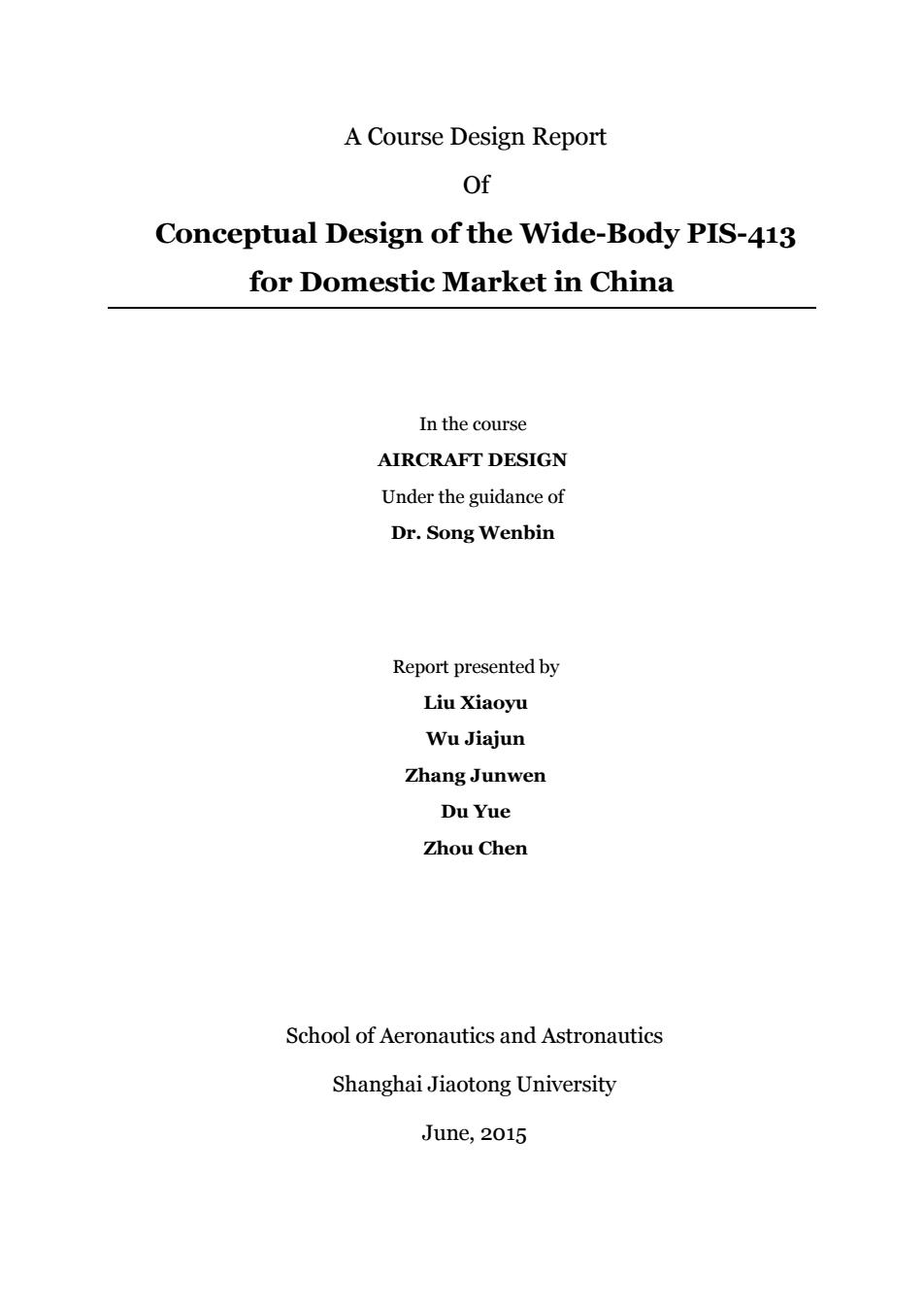
A Course Design Report Of Conceptual Design of the Wide-Body PIS-413 for Domestic Market in China In the course AIRCRAFT DESIGN Under the guidance of Dr.Song Wenbin Report presented by Liu Xiaoyu Wu Jiajun Zhang Junwen Du Yue Zhou Chen School of Aeronautics and Astronautics Shanghai Jiaotong University June,2015
A Course Design Report Of Conceptual Design of the Wide-Body PIS-413 for Domestic Market in China In the course AIRCRAFT DESIGN Under the guidance of Dr. Song Wenbin Report presented by Liu Xiaoyu Wu Jiajun Zhang Junwen Du Yue Zhou Chen School of Aeronautics and Astronautics Shanghai Jiaotong University June, 2015
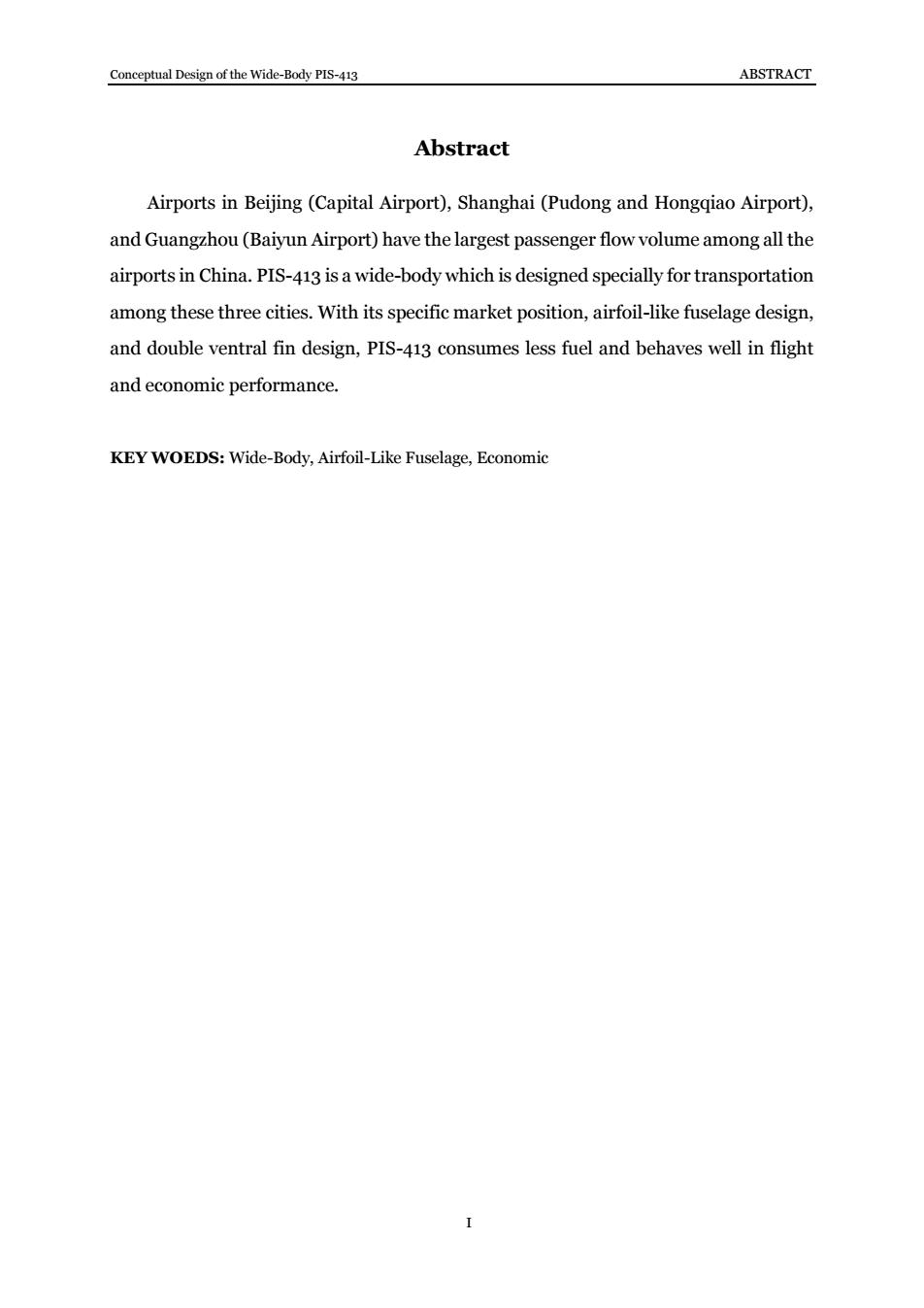
Conceptual Design of the Wide-Body PIS-413 ABSTRACT Abstract Airports in Beijing(Capital Airport),Shanghai (Pudong and Hongqiao Airport), and Guangzhou(Baiyun Airport)have the largest passenger flow volume among all the airports in China.PIS-413 is a wide-body which is designed specially for transportation among these three cities.With its specific market position,airfoil-like fuselage design, and double ventral fin design,PIS-413 consumes less fuel and behaves well in flight and economic performance. KEY WOEDS:Wide-Body,Airfoil-Like Fuselage,Economic I
Conceptual Design of the Wide-Body PIS-413 ABSTRACT I Abstract Airports in Beijing (Capital Airport), Shanghai (Pudong and Hongqiao Airport), and Guangzhou (Baiyun Airport) have the largest passenger flow volume among all the airports in China. PIS-413 is a wide-body which is designed specially for transportation among these three cities. With its specific market position, airfoil-like fuselage design, and double ventral fin design, PIS-413 consumes less fuel and behaves well in flight and economic performance. KEY WOEDS: Wide-Body, Airfoil-Like Fuselage, Economic
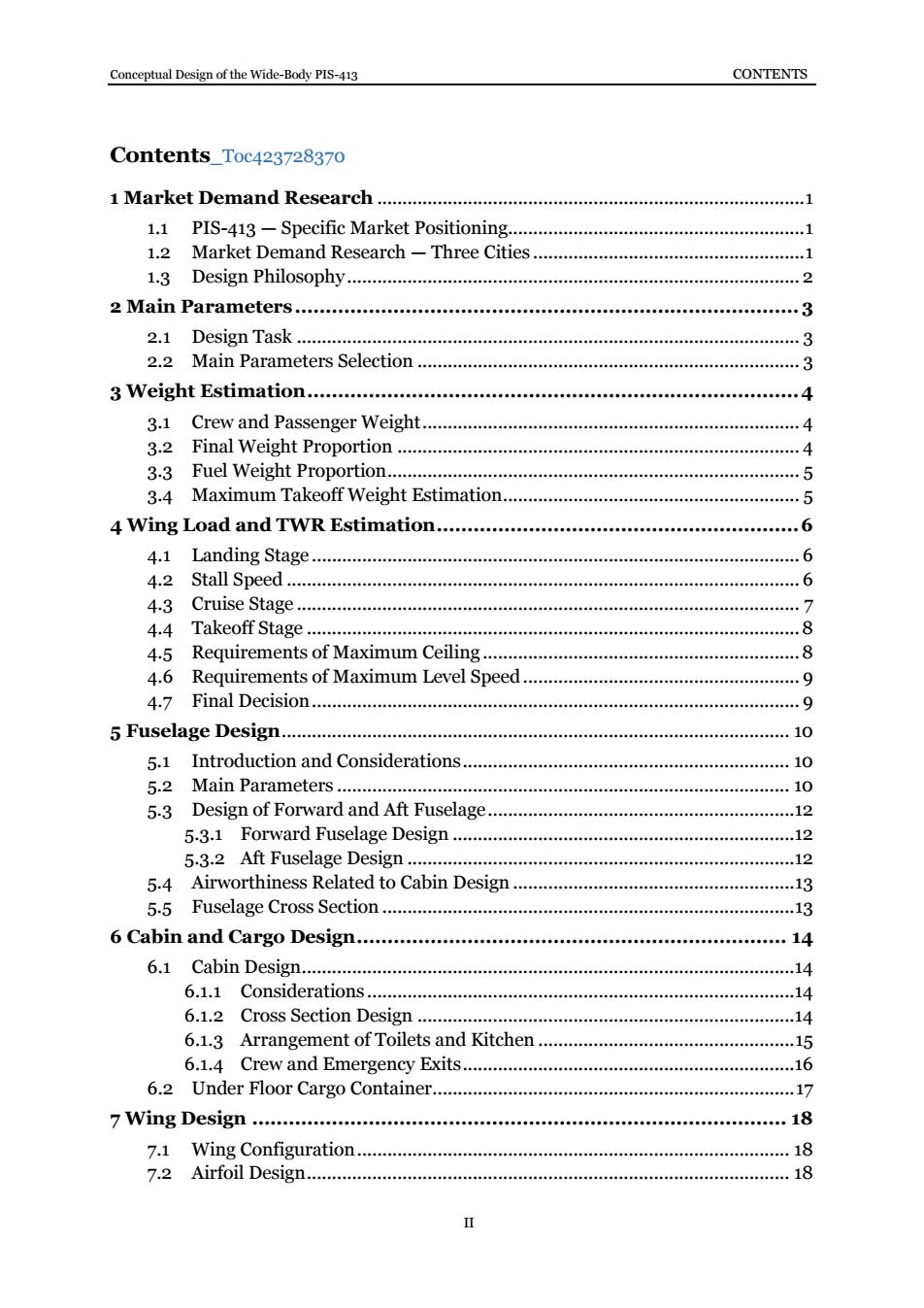
Conceptual Design of the Wide-Body PIS-413 CONTENTS Contents_Toc423728370 I Market Demand Research. 1.1 PIS-413 -Specific Market Positioning..1 1.2 Market Demand Research-Three Cities........ 1.3 Design Philosophy........... …2 2 Main Parameters.…3 2.1 Design Task ....... …3 2.2 Main Parameters Selection................... …3 3 Weight Estimation.… …4 3.1 Crew and Passenger Weight......... …4 3.2 Final Weight Proportion ............. …4 3.3 Fuel Weight Proportion........... …5 3.4 Maximum Takeoff Weight Estimation. …5 4 Wing Load and TWR Estimation.........................................6 4.1 Landing Stage.… …6 4.2 Stall Speed 6 4.3 Cruise Stage... …7 4.4 Takeoff Stage8 4.5 Requirements of Maximum Ceiling........ .8 4.6 Requirements of Maximum Level Speed............9 4.7 Final Decision.... …9 5 Fuselage Design.… …10 5.1 Introduction and Considerations........... .10 5.2 Main Parameters. …10 5.3 Design of Forward and Aft Fuselage............ .12 5.3.1 Forward Fuselage Design............ 12 5.3.2 Aft Fuselage Design.......... 12 5.4 Airworthiness Related to Cabin Design 13 5.5 Fuselage Cross Section.................. 13 6 Cabin and Cargo Design.................... …14 6.1 Cabin Design… .14 6.1.1 Considerations......... .14 6.1.2 Cross Section Design................... 14 6.1.3 Arrangement of Toilets and Kitchen........ 15 6.1.4 Crew and Emergency Exits.16 6.2 Under Floor Cargo Container...... .17 7 Wing Design.… 18 7.1 Wing Configuration..... .18 7.2 AirfoIl Design..18 0
Conceptual Design of the Wide-Body PIS-413 CONTENTS II Contents_Toc423728370 1 Market Demand Research .....................................................................................1 1.1 PIS-413 — Specific Market Positioning...........................................................1 1.2 Market Demand Research — Three Cities ......................................................1 1.3 Design Philosophy.......................................................................................... 2 2 Main Parameters ..................................................................................3 2.1 Design Task .................................................................................................... 3 2.2 Main Parameters Selection ............................................................................ 3 3 Weight Estimation................................................................................4 3.1 Crew and Passenger Weight........................................................................... 4 3.2 Final Weight Proportion ................................................................................ 4 3.3 Fuel Weight Proportion.................................................................................. 5 3.4 Maximum Takeoff Weight Estimation........................................................... 5 4 Wing Load and TWR Estimation...........................................................6 4.1 Landing Stage ................................................................................................. 6 4.2 Stall Speed ...................................................................................................... 6 4.3 Cruise Stage .................................................................................................... 7 4.4 Takeoff Stage ..................................................................................................8 4.5 Requirements of Maximum Ceiling ...............................................................8 4.6 Requirements of Maximum Level Speed ....................................................... 9 4.7 Final Decision................................................................................................. 9 5 Fuselage Design..................................................................................................... 10 5.1 Introduction and Considerations................................................................. 10 5.2 Main Parameters .......................................................................................... 10 5.3 Design of Forward and Aft Fuselage.............................................................12 5.3.1 Forward Fuselage Design ....................................................................12 5.3.2 Aft Fuselage Design .............................................................................12 5.4 Airworthiness Related to Cabin Design ........................................................13 5.5 Fuselage Cross Section ..................................................................................13 6 Cabin and Cargo Design...................................................................... 14 6.1 Cabin Design..................................................................................................14 6.1.1 Considerations .....................................................................................14 6.1.2 Cross Section Design ...........................................................................14 6.1.3 Arrangement of Toilets and Kitchen ...................................................15 6.1.4 Crew and Emergency Exits..................................................................16 6.2 Under Floor Cargo Container........................................................................17 7 Wing Design ....................................................................................... 18 7.1 Wing Configuration...................................................................................... 18 7.2 Airfoil Design................................................................................................ 18
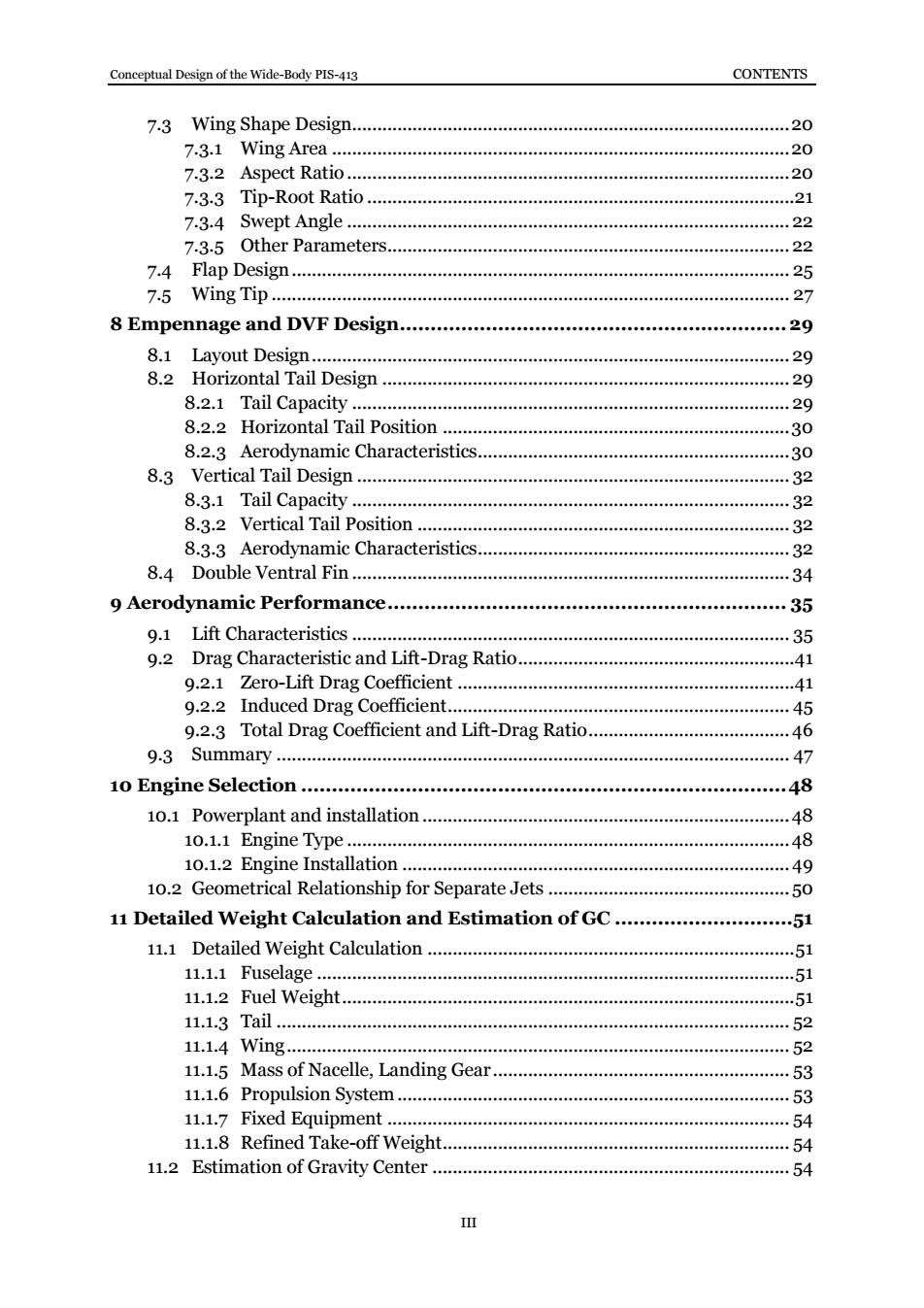
Conceptual Design of the Wide-Body PIS-413 CONTENTS 7.3 Wing Shape Design.............. .20 7.31 Wing Area.20 7.3.2 Aspect Ratio....... .20 7.3.3 Tip-Root Ratio.............. .21 7.3.4 Swept Angle..… 22 7.3.5 Other Parameters... 0…22 7.4 Flap Design......... …25 7.5 Wing Tip.. .27 8 Empennage and DVF Design....... …29 8.1 Layout Design.. …29 8.2 Horizontal Tail Design ............. …29 8.2.1 Tail Capacity.… …29 8.2.2 Horizontal Tail Position...... .30 8.2.3 Aerodynamic Characteristics... …30 8.3 Vertical Tail Design............. .32 8.3.1 Tail Capacity...... …32 8.3.2 Vertical Tail Position......32 8.3.3 Aerodynamic Characteristics.... …32 8.4 Double Ventral Fin...... …34 9 Aerodynamic Performance.................... …35 9.1 Lift Characteristics. …35 9.2 Drag Characteristic and Lift-Drag Ratio....... …41 9.2.1 Zero-Lift Drag Coefficient.41 9.2.2 Induced Drag Coefficient........ …45 9.2.3 Total Drag Coefficient and Lift-Drag Ratio....... .46 9.3 Summary.… …47 10 Engine Selection..........48 10.1 Powerplant and installation............... …48 10.1.1 Engine Type.… .48 10.1.2 Engine Installation...49 10.2 Geometrical Relationship for Separate Jets............. .50 11 Detailed Weight Calculation and Estimation of GC............................51 11.1 Detailed Weight Calculation ............. 51 11.1.1 Fuselage.. 51 11.1.2 Fuel Weight.… 51 11.1.3Tail …52 11.1.4Wing… …52 11.1.5 Mass of Nacelle,Landing Gear..53 11.1.6 Propulsion System............. …53 11.1.7 Fixed Equipment..... .54 11.1.8 Refined Take-off Weight........ …54 11.2 Estimation of Gravity Center................... .54 Ⅱ
Conceptual Design of the Wide-Body PIS-413 CONTENTS III 7.3 Wing Shape Design.......................................................................................20 7.3.1 Wing Area ...........................................................................................20 7.3.2 Aspect Ratio ........................................................................................20 7.3.3 Tip-Root Ratio .....................................................................................21 7.3.4 Swept Angle ........................................................................................ 22 7.3.5 Other Parameters................................................................................ 22 7.4 Flap Design................................................................................................... 25 7.5 Wing Tip ....................................................................................................... 27 8 Empennage and DVF Design...............................................................29 8.1 Layout Design............................................................................................... 29 8.2 Horizontal Tail Design ................................................................................. 29 8.2.1 Tail Capacity ....................................................................................... 29 8.2.2 Horizontal Tail Position .....................................................................30 8.2.3 Aerodynamic Characteristics..............................................................30 8.3 Vertical Tail Design ...................................................................................... 32 8.3.1 Tail Capacity ....................................................................................... 32 8.3.2 Vertical Tail Position .......................................................................... 32 8.3.3 Aerodynamic Characteristics.............................................................. 32 8.4 Double Ventral Fin ....................................................................................... 34 9 Aerodynamic Performance................................................................. 35 9.1 Lift Characteristics ....................................................................................... 35 9.2 Drag Characteristic and Lift-Drag Ratio.......................................................41 9.2.1 Zero-Lift Drag Coefficient ...................................................................41 9.2.2 Induced Drag Coefficient.................................................................... 45 9.2.3 Total Drag Coefficient and Lift-Drag Ratio........................................46 9.3 Summary ...................................................................................................... 47 10 Engine Selection ...............................................................................48 10.1 Powerplant and installation .........................................................................48 10.1.1 Engine Type ........................................................................................48 10.1.2 Engine Installation .............................................................................49 10.2 Geometrical Relationship for Separate Jets ................................................ 50 11 Detailed Weight Calculation and Estimation of GC .............................51 11.1 Detailed Weight Calculation .........................................................................51 11.1.1 Fuselage ...............................................................................................51 11.1.2 Fuel Weight..........................................................................................51 11.1.3 Tail ...................................................................................................... 52 11.1.4 Wing.................................................................................................... 52 11.1.5 Mass of Nacelle, Landing Gear ........................................................... 53 11.1.6 Propulsion System.............................................................................. 53 11.1.7 Fixed Equipment ................................................................................ 54 11.1.8 Refined Take-off Weight..................................................................... 54 11.2 Estimation of Gravity Center ....................................................................... 54
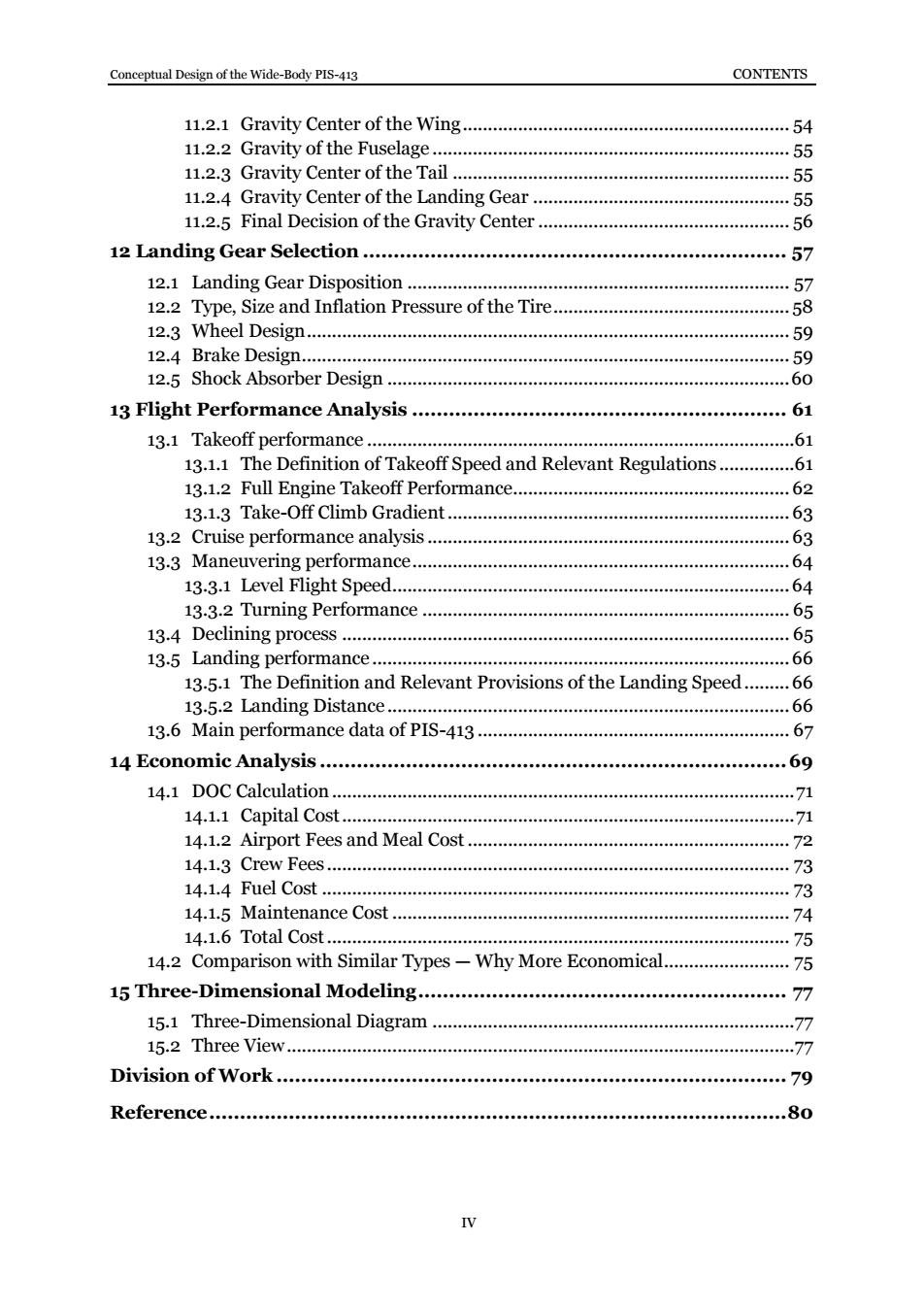
Conceptual Design of the Wide-Body PIS-413 CONTENTS 11.2.1 Gravity Center of the Wing...... .54 11.2.2 Gravity of the Fuselage........55 11.2.3 Gravity Center of the Tail ............. .55 11.2.4 Gravity Center of the Landing Gear...55 11.2.5 Final Decision of the Gravity Center.............. .56 12 Landing Gear Selection.......57 12.1 Landing Gear Disposition ........... 57 12.2 Type,Size and Inflation Pressure of the Tire.....................58 12.3 Wheel Design.… …59 12.4 Brake Design... .59 12.5 Shock Absorber Design............... .60 13 Flight Performance Analysis.............61 13.1 Takeoff performance............. .61 13.1.1 The Definition of Takeoff Speed and Relevant Regulations...............61 13.1.2 Full Engine Takeoff Performance...........62 13.1.3 Take-Off Climb Gradient................. .63 13.2 Cruise performance analysis............. .63 13.3 Maneuvering performance..... .64 13.3.1 Level Flight Speed............... .64 13.3.2 Turning Performance ........... .65 13.4 Declining process...65 13.5 Landing performance............. .66 13.5.1 The Definition and Relevant Provisions of the Landing Speed.........66 13.5.2 Landing Distance............. .66 13.6 Main performance data of PIS-413.... .67 14 Economic Analysis.................... .69 14.1D0 C Calculation… .71 14.1.1 Capital Cost...... .71 14.1.2 Airport Fees and Meal Cost..... …72 14.1.3 Crew Fees..... …73 14.1.4 Fuel Cost ........... 73 14.1.5 Maintenance Cost.............. …74 14.1.6 Total Cost......... …75 14.2 Comparison with Similar Types-Why More Economical. .75 15 Three-Dimensional Modeling.......... 77 15.1 Three-Dimensional Diagram........ …77 15.2 Three View............ …77 Division of Work.................. …79 Reference.… .80 IV
Conceptual Design of the Wide-Body PIS-413 CONTENTS IV 11.2.1 Gravity Center of the Wing................................................................. 54 11.2.2 Gravity of the Fuselage ....................................................................... 55 11.2.3 Gravity Center of the Tail ................................................................... 55 11.2.4 Gravity Center of the Landing Gear ................................................... 55 11.2.5 Final Decision of the Gravity Center .................................................. 56 12 Landing Gear Selection ..................................................................... 57 12.1 Landing Gear Disposition ............................................................................ 57 12.2 Type, Size and Inflation Pressure of the Tire............................................... 58 12.3 Wheel Design................................................................................................ 59 12.4 Brake Design................................................................................................. 59 12.5 Shock Absorber Design ................................................................................60 13 Flight Performance Analysis ............................................................. 61 13.1 Takeoff performance .....................................................................................61 13.1.1 The Definition of Takeoff Speed and Relevant Regulations ...............61 13.1.2 Full Engine Takeoff Performance....................................................... 62 13.1.3 Take-Off Climb Gradient.................................................................... 63 13.2 Cruise performance analysis ........................................................................ 63 13.3 Maneuvering performance...........................................................................64 13.3.1 Level Flight Speed............................................................................... 64 13.3.2 Turning Performance ......................................................................... 65 13.4 Declining process ......................................................................................... 65 13.5 Landing performance ................................................................................... 66 13.5.1 The Definition and Relevant Provisions of the Landing Speed .........66 13.5.2 Landing Distance ................................................................................ 66 13.6 Main performance data of PIS-413 .............................................................. 67 14 Economic Analysis ............................................................................69 14.1 DOC Calculation............................................................................................71 14.1.1 Capital Cost..........................................................................................71 14.1.2 Airport Fees and Meal Cost ................................................................ 72 14.1.3 Crew Fees ............................................................................................ 73 14.1.4 Fuel Cost ............................................................................................. 73 14.1.5 Maintenance Cost ............................................................................... 74 14.1.6 Total Cost............................................................................................ 75 14.2 Comparison with Similar Types — Why More Economical......................... 75 15 Three-Dimensional Modeling............................................................ 77 15.1 Three-Dimensional Diagram ........................................................................77 15.2 Three View.....................................................................................................77 Division of Work ................................................................................... 79 Reference..............................................................................................80